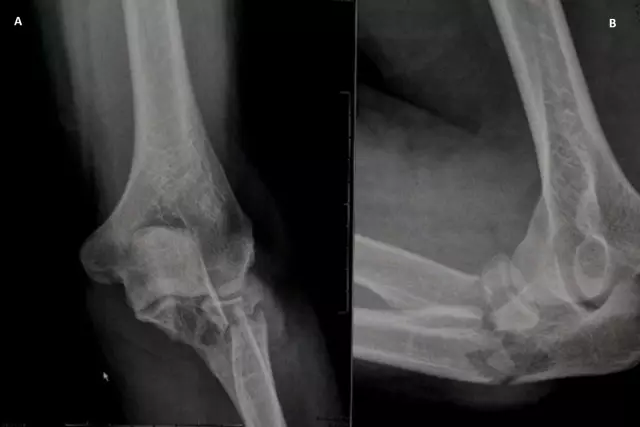- Author Rachel Wainwright [email protected].
- Public 2023-12-15 07:39.
- Last modified 2025-11-02 20:14.
Sternum
The sternum is an unpaired elongated bone with a slightly convex anterior part and a concave posterior surface.

The structure of the sternum
The sternum is located in the section of the anterior chest wall. It consists of three parts: the handle, the body and the xiphoid process. All three parts are interconnected by cartilaginous layers that ossify with age.
The sternum handle is its widest part. It is thicker from above, thinner from below, and at the very bottom it has a jugular notch on the upper edge, which is easy to feel through the skin. On the sides of the jugular notch are the clavicular notches - the places where the sternum connects to the sternal ends of the clavicles.
Slightly lower, on the lateral edge, is the notch of the first rib - the junction with the cartilage of the first rib. A little lower, you can see a small depression - the upper part of the rib notch of the second rib. The bottom of this notch is located directly on the body of the sternum.
The body of the sternum is almost three times longer than the handle, but narrower than it. Women have a shorter body than men.
In the front part, you can see traces of the fusion of parts of the sternum during embryonic development. They look like transverse, faintly visible lines.
The connecting cartilage of the upper edge of the body with the lower edge of the arm is called arm synchondrosis. The handle and the body are connected, forming an obtuse, behind an open angle, which is at the level of the junction of the second rib. It is easy to feel through the skin.
On the lateral part of the body of the sternum there are two incomplete and four complete costal notches - the junction of the ribs with cartilage (from the second to the seventh). One incomplete notch is located on top of the lateral part of the sternum and corresponds to the cartilage of the second rib, the other - below the lateral part and corresponds to the cartilage of the seventh rib. Between them are four full notches corresponding to the third, fourth, fifth, and sixth ribs.
The parts of the lateral sections located between two adjacent costal notches have the form of semilunar depressions.
The shortest part of the sternum is the xiphoid process. It can vary in shape and size, have a hole in the middle or a forked top. Its blunt or sharp tip can be turned both forward and backward. In the upper part of the lateral process, there is an incomplete notch, which connects to the cartilage of the seventh rib.
Together with the body, the xiphoid process forms a synchondrosis of the xiphoid process. In old age, the xiphoid process ossifies and grows together with the body of the sternum.
Sometimes above the handle, in the middle of the suprahyoid muscle group of the sternum or in the medial leg of the clavicular-mastoid muscle of the sternum, there are from one to three sternum bones, which are connected to its handle.
The main muscle of the sternum is the pectoralis major muscle, which starts at the medial surface of the clavicle, passes through the body and hilt of the sternum, and the rectus abdominis muscle.
Pain and burning in the sternum
Most often, pain in the sternum is associated with damage to internal organs and its bone-cartilaginous structures, as well as psychogenic diseases. Often sternum pain is a symptom of myocardial infarction, angina pectoris, pulmonary embolism, pneumonia, diseases of the gastrointestinal tract, mitral valve prolapse, pleurisy, dissecting aortic aneurysm, malignant neoplasm of the lung, diaphragmatic abscess.
Pain and burning sensation in the sternum is an integral symptom:
- Diseases of the gastrointestinal tract (stomach ulcer, gastroesophageal disease);
- Diseases of the broncho-pulmonary system;
- Diseases of the cardiovascular system;
- Blood diseases;
- Injuries and fractures of the sternum.
In addition, a psychogenic origin of pain in the sternum (hysteria, vascular dystonia) is possible.
Sternum fracture
In traumatology, a fracture of the sternum is quite rare. Typically, the fracture occurs as a result of a strong direct blow to the chest, in a traffic accident (as a result of the impact of the chest against the steering column) or as a result of strong compression of the chest. The fracture is often accompanied by displacement of the fragments. A displacement fracture is characterized by an indentation of the center of the sternum inward.
Sternum fracture symptoms
The most obvious symptom of a fracture is pain in the damaged area, which increases with breathing. In the area of the fracture, hemorrhage and swelling can be seen. Palpation is very painful, and in some patients, fragments of the sternum can be felt.
A non-displaced fracture may not cause severe pain, especially if the injury is combined with multiple rib fractures.
A fracture with a strong displacement of fragments can damage the organs of the chest. As a result of damage to the lungs or pleura, pneumothorax (accumulation of air) or hemothorax (accumulation of blood) in the chest can develop. Such complications pose a serious threat to the patient's life and require immediate medical attention.
Found a mistake in the text? Select it and press Ctrl + Enter.






